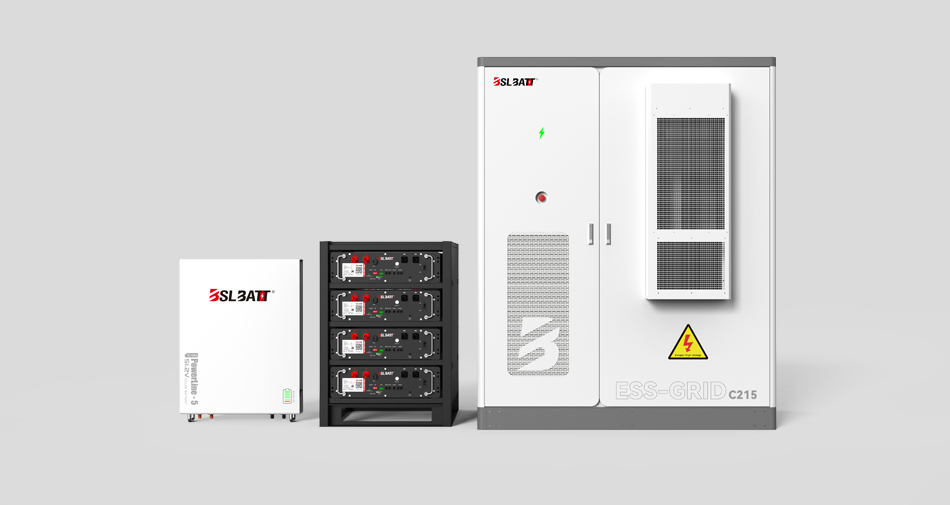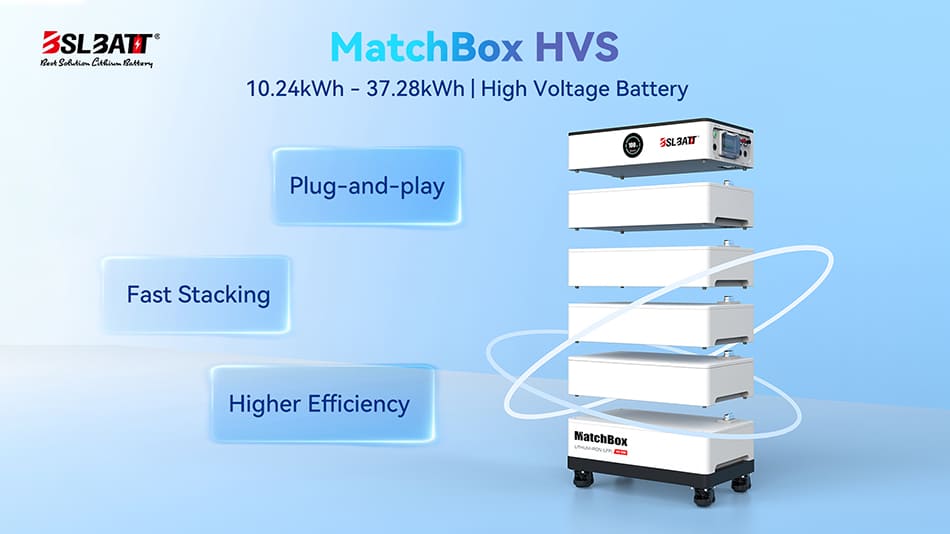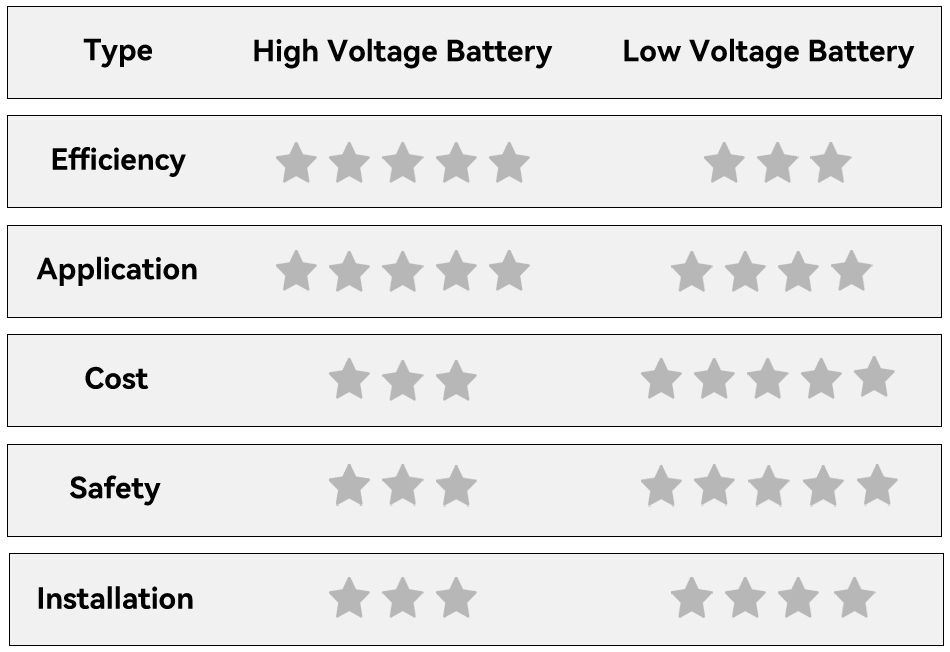In today’s energy storage systems, selecting the right type of battery is crucial, especially in residential, commercial, and industrial applications. Whether it’s for storing power from solar systems or powering electric vehicles (EVs), the battery voltage plays a significant role in determining the system’s efficiency, safety, and cost. High voltage (HV) and low voltage (LV) batteries are two common options, each offering unique advantages and use cases. So, when building or upgrading your energy storage system, how do you choose the best type of battery? In this article, we’ll take an in-depth look at the differences between high voltage and low voltage batteries to help you make an informed decision.
What is A High Voltage (HV) Battery?
In the context of energy storage systems, we usually define a battery system with a rated voltage in the range of 90V-1000V as a high voltage system. This type of energy storage system is often used for larger energy needs, such as commercial and industrial energy storage, electric vehicle charging stations, etc. Paired with a three-phase hybrid inverter, it can handle high power loads and provide higher efficiency and performance in systems that require large amounts of energy output over a long period of time.
Related Page: View BSLBATT High Voltage Batteries
What Are The Advantages of High Voltage Batteries?
Higher transmission efficiency
One of the advantages of high-voltage batteries is the improved energy transfer efficiency of the storage system. In applications where energy demand is greater, the increased voltage means that the storage system requires less current to deliver the same amount of power, which reduces the amount of heat generated by the operation of the battery system and avoids unnecessary energy loss. This increase in efficiency is particularly important for energy storage systems in excess of 100kWh.
Greater scalability
High voltage battery systems are also scalable, but usually based on larger battery capacities, ranging from 15kWh – 200kWh for a single battery pack, making them the preferred choice for small manufacturers, solar farms, community power, microgrids and more.
Reduced cable size and cost
Due to the increase in voltage, the same amount of power produces less current, so high voltage battery systems do not need to make more sinks and therefore only need to use smaller sized cables, which saves on material costs and greatly reduces the complexity of the installation.
Better performance in high power applications
In electric vehicle charging stations, industrial manufacturers, and grid-scale energy storage applications, which often involve high power outputs, high-voltage battery systems are very good at handling large power surges, which can greatly improve the stability and reliability of an organization’s power consumption, thereby protecting critical loads, improving efficiency, and reducing costs.
Disadvantages of High Voltage Battery Systems
Of course there are two sides to everything and high voltage battery systems have their own drawbacks:
Safety Risks
The biggest disadvantage of high voltage battery systems is the increased risk of the system. When operating and installing a high voltage battery system, you need to be prepared to wear insulating and protective clothing to avoid the risk of high voltage shock.
TIPS: High-voltage battery systems require more stringent safety procedures, including specialized circuit protection, insulated tools, and trained installation and maintenance technicians.
Higher Upfront Costs
While high-voltage energy storage systems enhance battery and energy conversion efficiency, the complexity of the system components (additional safety equipment and protection features) increases the upfront investment costs. Each high-voltage system has its own high-voltage box with a master-slave architecture for battery data acquisition and control, while low-voltage battery systems do not have a high-voltage box.
What is a low voltage battery?
In energy storage applications, batteries that typically operate at 12V – 60V are referred to as low voltage batteries, and they are commonly used in off-grid solar solutions such as RV batteries, residential energy storage, telecom base stations, and UPS. Commonly used battery systems for residential energy storage are typically 48V or 51.2 V. When expanding capacity with a low voltage battery system, the batteries can only be connected in parallel with each other, so the voltage of the system does not change. low voltage batteries are often used where safety, ease of installation, and affordability are key considerations, especially in systems that don’t require a large amount of sustained power output.
Related Page: View BSLBATT Low Voltage Batteries
Advantages of Low Voltage Batteries
Enhanced Safety
Safety is often one of the primary considerations for homeowners when choosing an energy storage system, and low voltage battery systems are favored for their inherent safety. Low-voltage levels are effective in reducing battery risk, both during installation, use and maintenance, and so have made low-voltage batteries the most common and frequently used battery type for home energy storage applications.
Higher Economy
Low-voltage batteries are more cost-effective because of their lower BMS requirements and more mature technology, which makes them less expensive. Likewise the system design and installation of low voltage batteries is simpler and the installation requirements are lower, so installers can deliver faster and save on installation costs.
Suitable for Small-scale Energy Storage
For homeowners with rooftop solar panels or businesses that need backup power for critical systems, low voltage batteries are a reliable and efficient energy storage solution. The ability to store excess solar energy during the day and use it during peak hours or power outages is a major advantage, allowing users to save on energy costs and reduce reliance on the grid.
Disadvantages of low voltage battery systems
Lower Efficiency
The efficiency of energy transfer is generally lower than that of high-voltage battery systems because of the higher current required to deliver the same amount of power, which leads to higher temperatures in the cables and connections as well as in the internal cells, resulting in unnecessary energy loss.
Higher Expansion Costs
Low-voltage battery systems are expanded by paralleling, so the voltage of the system stays the same, but the current is multiplied, so in multiple parallel installations you need thicker cables to handle the higher currents, which results in higher material costs, and the more paralleled the system, the more complex the installation. Generally, if more than 2 batteries are connected in parallel, we will recommend customers to use busbar or bus box for installation.
Limited Scalability
Low-voltage battery systems have limited scalability, because with the increase of batteries, the efficiency of the system will become lower and lower, and the information between the batteries to collect a huge amount of data, the processing will also be slower. Therefore, for larger energy storage systems, it is recommended to use high voltage battery systems to be more reliable.
Difference Between High Voltage and Low Voltage Batteries
HV and LV Battery Data Comparison
| Picture | 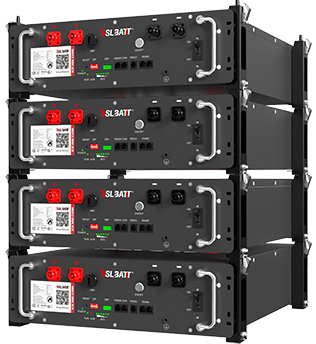 |
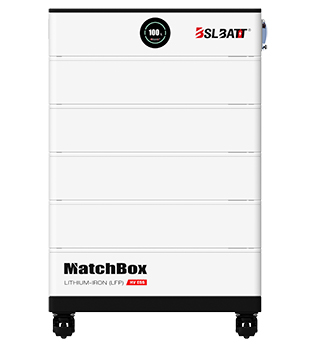 |
| Type | B-LFEP48-100E | Matchbox HVS |
| Nominal Voltage (V) | 51.2 | 409.6 |
| Nominal Capacity (Wh) | 20.48 | 21.29 |
| Dimension(mm)(W*H*D) | 538*483(442)*544 | 665*370*725 |
| Weight(Kg) | 192 | 222 |
| Rate. Charging Current | 200A | 26A |
| Rate. Discharging Current | 400A | 26A |
| Max. Charging Current | 320A | 52A |
| Max. Discharging Current | 480A | 52A |
Which is Best for Your Energy Storage Needs?
Both high-voltage and low-voltage battery systems have their own particular advantages, and there are a number of main factors to consider when making a choice for your energy storage system, including energy needs, budget and safety considerations.
However, if you are just starting from different applications, we recommend you to make your choice according to the following:
Low voltage battery systems:
- Residential Solar Storage: Storing power during the day for use during peak demand periods or at night.
- Emergency Backup Power: Keeps essential appliances and equipment running during power outages or brownouts.
High Voltage Battery Systems:
- Commercial energy storage: Ideal for companies with large solar arrays, wind farms or other renewable energy projects.
- Electric Vehicle (EV) Infrastructure: High voltage batteries are ideal for powering EV charging stations or fleets.
- Grid-Level Storage: Utilities and energy service providers often rely on high-voltage systems to manage large energy flows and ensure grid stability.
In summary, consider choosing a high-voltage energy storage battery for homes with large numbers of people, high power loads, and high demands on charging time, and vice versa for low-voltage storage batteries. By carefully evaluating your energy storage needs-whether it’s a home solar system or a large commercial installation-you can choose a battery that aligns with your goals, ensuring long-term efficiency and reliability.
Post time: Sep-06-2024









